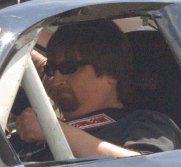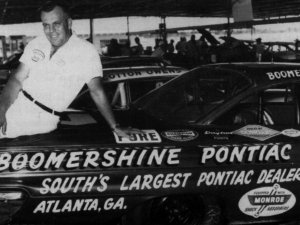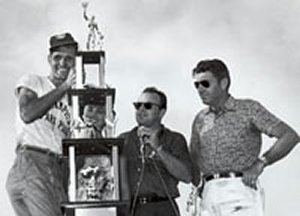
Brandon Reed
By Brandon Reed
Posted in Columns 5/28/10
The first World 600 at Charlotte Motor Speedway was a grueling event that broke several cars, and several hearts before the checkered flag fell.
Track builders Curtis Turner and Bruton Smith had run into a lot of trouble in getting the track done in time for the first NASCAR event on the big track.
The asphalt had not had enough time to set before the race, and as more and more cars took to the track, the racing surface began to come up. That led NASCAR officials to allow drivers to add special screens to protect portions of the windshields, as well as tire flaps to try to deflect rocks and chunks of the racing surface from being kicked up.

Georgia Hall of Fame driver Jack Smith had the first World 600 well in hand until a chunk of asphalt intervened.
Fireball Roberts sat on the pole for that first race in a lightning fast Pontiac. From the drop of the green flag, Roberts ran away from the field. As other drivers had issues, Roberts bombed his way around the track.
But the hard charging Floridian cut a tire, forcing his fast Pontiac into the guardrail, and ending his day after 191 laps.
Of those, Roberts had led 114.
The next driver to fall victim was Georgia Racing Hall of Fame member Jack Smith. Smith would lead 198 of the race’s 400 laps, piloting Bud Moore’s 1960 Pontiac. As other contenders such as Turner, “Tiger Tom” Pistone, and Junior Johnson fell by the wayside, Smith held a commanding lead.
But that crumbling racing surface struck again. As Smith continued to lead, it became obvious that there was a problem. He roared down pit road, with fluid trailing his number 47 Pontiac.
A chunk of asphalt had kicked up from the racing surface, and punched a hole in Smith’s gas tank.
Crew members tried desperately to plug the hole, but nothing worked. They tried using rags to stop the leak, then attempted to use chewing gum and even a bar of soap to seal the hole. Each time, Smith would return to the track only to have to return with fuel pouring from the back end.
Smith was finally forced to retire from the race, credited with having run 352 laps.

Joe Lee Johnson, driving a Chevy prepared by GRHOF member Paul McDuffie, recorded the win in the first World 600.
That handed the lead over to Chattanooga’s Joe Lee Johnson, piloting a 1960 Chevy that had been wrenched by legendary Georgia mechanic Paul McDuffie, himself now a member of the Georgia Racing Hall of Fame. Johnson held a four-lap lead over the second place car of Johnny Beauchamp. Johnson held on to win the first World 600, pocketing a cool $27,000 for the win.
But the controversy of the race wasn’t over. Three Petty Enterprises entries, piloted by Lee Petty, Richard Petty, and Bobby Johns, had all pulled off top ten finishes in the grueling grind. But when Lee and Richard went to the pay off window to pick up their winnings, they were told NASCAR officials had disqualified them, robbing them of all winnings and points for the event.
Before the race, officials had warned drivers not to cut through the grass between the front stretch and pit road. If they did, officials said, they would be disqualified.
During the course of the event, both Lee and Richard were caught up in separate incidents that sent them spinning through the grass. Rather than cut back on the track and into traffic, both had made the decision to cut to pit road to get back up to speed.
The Pettys said it was common sense to make such a move. NASCAR didn’t see it as such, and pulled both drivers’ scoring cards. However, no officials ever told the Pettys this had been done, effectively giving them a free show from the two drivers.
So, as you can see, controversy and heartbreak are nothing new to the Charlotte track. It started right from the time the first shovel full of dirt was turned. But it’s also what makes it such a grand track that everybody wants to beat.
Editor’s note: Portions of this column were originally published in the May 29, 2008 edition of The Jackson Herald.
Brandon Reed is the editor and webmaster of Georgia Racing History.com.
Questions, comments, suggestions? Email us!
This website is not affiliated with or endorsed by the Georgia Racing Hall of Fame or the Georgia Auto Racing Hall of Fame Association, Inc. All content is the intellectual property of the individual authors. All opinions are those of the individual authors. Please do not repost images or text without permission.
